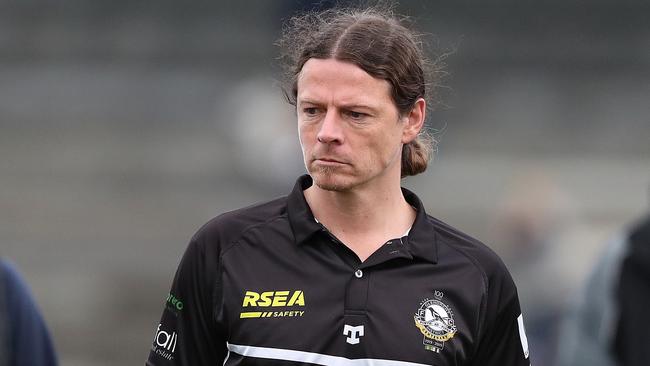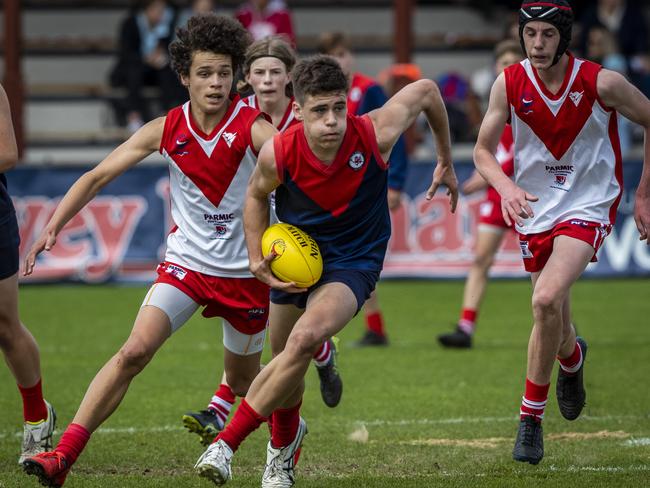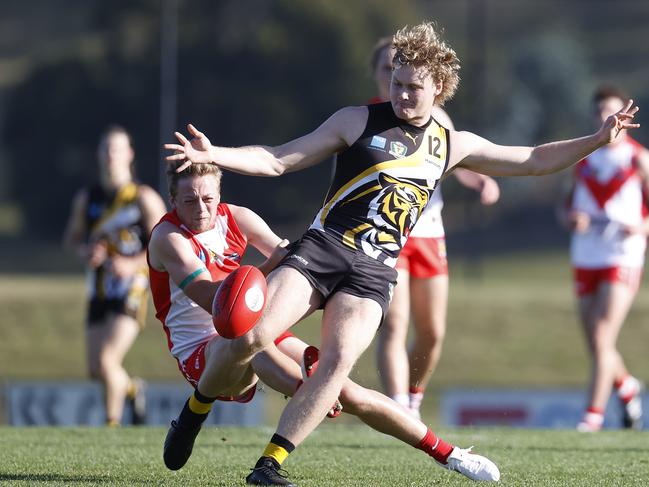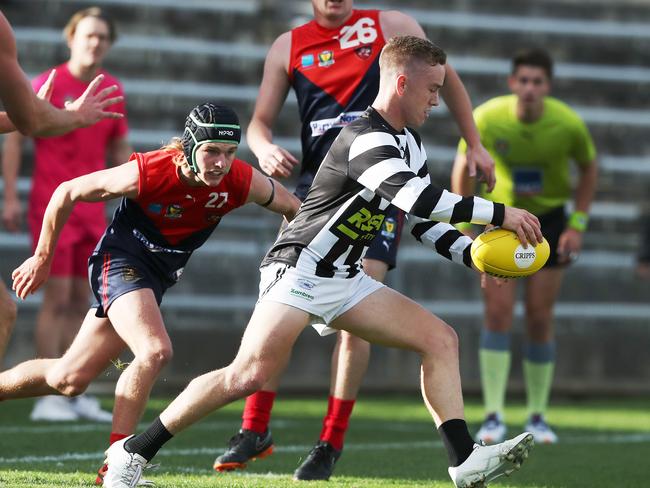Urgent help required to save ‘sick’ Tasmanian football, say those on the frontline
Once the strongest sport in the state, football is in serious decline and needs urgent, lifesaving help according to multiple top-level coaches.
Opinion
Don't miss out on the headlines from Opinion. Followed categories will be added to My News.
- Tassie triathlete back on international stage
- Expansion or relocation? Everything on the table in review
FOOTBALL is on its sick bed and the demise of the TSL will send the game back a decade, say those at the coalface.
Three TSL coaches have raised concerns over the plight of the game following North Hobart president Craig Martin raising doubts on the future of the code in Tasmania without urgent funding increases and a vision for the future. (see his Talking Point below)
The TSL has licence agreements with AFL Tasmania until 2023, but if the AFL pulls the pin on the competition, it must give 12 months notice to participating clubs – meaning a decision could be made next season.
Jeromey Webberley (Clarence), Paul Kennedy (Glenorchy) and Daniel Willing (Lauderdale) all raised concerns over the decline participation and the flow-on that would affect senior football.
Webberley was clear in how desperate the situation was.
“The game is sick at the moment and we can talk about an AFL team and what the TSL looks like, but if we don’t fix underneath, it doesn’t matter what’s on top,” he said.
“We could drop an AFL team here in five years, it is not going to fix participation because it will be gone.”

Head of AFL Tasmania Damian Gill said official figures showed participation had actually grown the past five years with 2021 on track to meet or exceed pre-COVID numbers.
“We acknowledge there are challenges and concerns from parts of community football, including but not limited to the distribution of players across clubs and competitions,” Gill said.
“It is important we look at the landscape holistically and consult deeply.
“The best structure for Tasmanian community football in the future is something we are looking closely at, with more to be communicated soon.”
Willing backed Martin’s call for an urgent lift in the TSL salary cap from $80,000 to retain the best players and attract former AFL and VFL players while Kennedy said the end of the women’s state league, the TSLW, was a warning sign for what could happen in the men’s league with players lost due to the switch back to regional football.
“If you don’t have a state competition … you have mediocrity,” Kennedy said.
“We’ve seen that in the women’s competition this year.
“If we went down that track on the TSL side of things we would just be putting Tasmanian footy back again for a decade.
“We’d be having the same thing that happened through the 2000s and then we would have to have the same process of lifting it up.”

He said the loss of youth-age footballers – those aged 13 to 18 – in Tasmania was above that compared to other states.
“Footy is not just about the ones who get drafted to the AFL,” he said.
“It is about all these kids who get involved and how it helps them become good young men and women and the lessons they learn and the adolescent years are the huge ones.
“We are failing them by not having the right aspirational model for kids at that age group and now we are seeing the result of it at senior footy because that failure has been there for a long time now.”
How can we save football in Tassie?
Aussie rules football in Tasmania is in a desperate state and needs an urgent and extensive overhaul — including a Tasmanian team in the AFL, argues CRAIG MARTIN.
ON page 21 of the excellent AFL Taskforce report is a section entitled A Game Under Threat.
I have been involved in footy all my life in Tasmania and I have never seen the game that we love in this state at such a crossroads moment like now.
First and foremost, what is the plan, the vision for the game here? What is the strategic direction for footy in Tasmania? There isn’t any.
The plan for the future must be for a home-grown Tasmanian AFL team with its own talent academy, underpinned by a strong, well-resourced Tasmanian State or Premier League that includes a team from one of the great footy heartlands, the North-West Coast, and greater autonomy in decision-making about the game by Tasmanians for Tasmania.
An AFL team will rekindle interest in footy in the state and give us direction. It will also pay healthy dividends into community footy.
An AFL team will deliver sustainable growth in participation, which is what has happened in Western Sydney and South-East Queensland with the advent of GWS and the Gold Coast Suns – teams to which the AFL has contributed tens of millions of dollars.
It will unquestionably help to address the significant decline of boys and young men participating in football in the state over the past 10-15 years.
Between 2006 and 2017 there was a drop of 14.7 per cent in males playing the game in Tasmania.
Most alarming was a 22 per cent drop in males aged 13-18 playing the game — critical ages because these ages are the conduit between junior and senior football. This was during a period where in all other football states male participation grew between 5 and 20 per cent. (Source AFL Tasmania Junior/Youth Football Review 2017 and published in the Mercury in July 2018).

Such has been the decline in male participation and the lack of direction and engagement from the game’s governing body here, that in pursuing a Tasmanian AFL team the Tasmanian government in 2019 put in place its own body — the Tasmanian Football Board — to address these issues.
Tasmania is about to get a national basketball team which poses another threat to participation and interest in football in the state.
When we do have our own AFL team we should aspire to a similar model to football in South Australia where the State’s premier football competition, the SANFL, underpins the two AFL teams and the game is run by a nine-person independent commission (currently chaired by Rob Kerin a former Premier of SA) on behalf of the SANFL clubs and all South Australian community and junior football.
It works very well, and I believe the Tasmanian Football Board could become such a body.
Tasmanian State League (TSL) clubs have had their funding cut by about 40 per cent in 2021 (our licence agreement stipulates $110,000 and we will receive $60,000 this year) and we have not been provided with any surety of funding beyond 2023 or any guarantees that the TSL will continue beyond the expiration of the current licence agreement, which ends at the end of 2023.
How can we plan for the future if we don’t know how much funding we’ll receive and what competition we are playing in?

AFL Tasmania also decided that the TSL salary cap would be reduced in 2021 from $95,000 to $80,000 despite all clubs except one saying they didn’t want it reduced.
In South Australia and Western Australia, their premier competitions have salary caps of $210,000 and $200,000 respectively for 2021. And these caps were cut considerably due to COVID. West Australian clubs are now lobbying for their cap to be lifted to $500,000.
In comparison, the TSL salary cap of $80,000 is a joke.
In South Australia and Western Australia, all the best players not playing in the two AFL teams play in their premier football competition.
Is it any wonder they are getting heaps of kids drafted? It’s because their best young players are playing against men each week who can seriously play!
This has not been the case here. It was 30 years ago, but not now.
A well-resourced state league like the SANFL would also address the considerable drain of talented young players from Tasmania to other competitions on the mainland and see more Tasmanians drafted.
It will also attract good quality players from the mainland improving the standard of local footy.

We’ve lost players to the SANFL and other mainland competitions and it’s heartbreaking and symptomatic of the decline and lack of ambition and vision for the game here.
TSL teams are also struggling to retain players — many of whom are poached while still under contract — by lower-level competitions that offer more money and have no salary cap and no policing of their player payments.
This was raised as a major issue by TSL clubs in 2018 and is now finally being addressed by the Tasmanian Football Board, AFL Tasmania and all the leagues and associations in Tasmania, which is welcome. However, it needs to be properly policed, and the salary caps need to clearly differentiate the TSL from the competitions that sit below it.
As well as being top of the pay scale, an annual opportunity for TSL players to represent the state would also greatly assist in differentiating the product as would income protection insurance.
For footy to prosper and grow, the game needs an urgent and radical reset, and the reset must start with:
A STRATEGIC plan and vision for the game in the state created with input from all key footy stakeholders.
A TASMANIAN AFL team with its own talent academy.
A PROPERLY resourced statewide or premier league with North-West Coast representation and a decent salary cap of at least $200,000.
SALARY caps for lower-level competitions well below that and properly policed.
A GOVERNANCE model for administration of the game in Tasmania that gives us more autonomy and say on the future direction of the game here.
This will require investment from the state government, the AFL and dividends from our AFL team flowing into footy at all levels in the state.
If the above occurs, the game here will prosper and be revitalised, and we will see more talented Tasmanians drafted to the AFL.
We simply cannot keep going the way we are.
Craig Martin is President of the North Hobart Football Club. He was also the executive director of Sport and Recreation in Tasmania for more than seven years.



